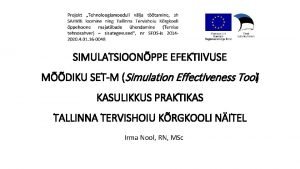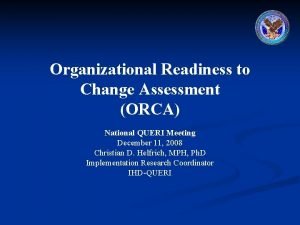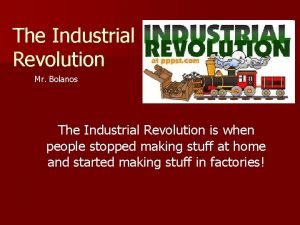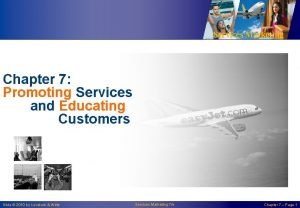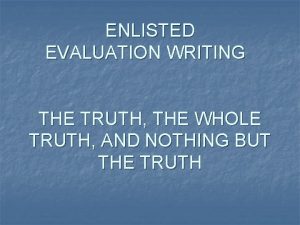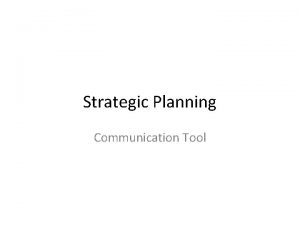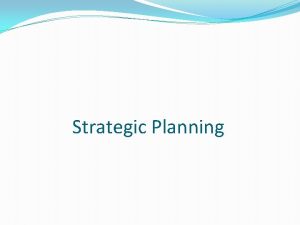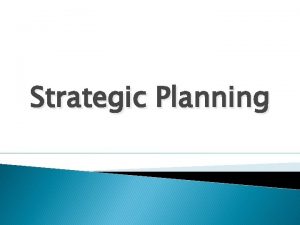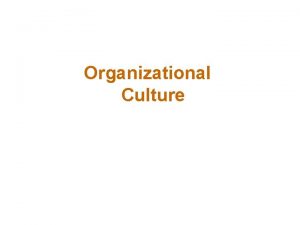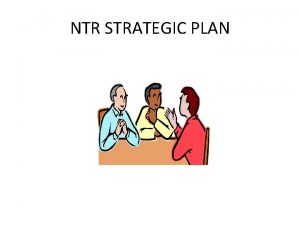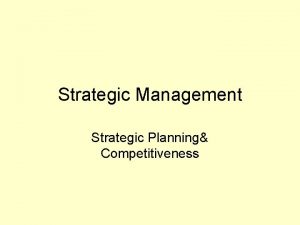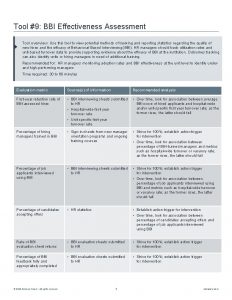STRATEGIC PLANNING A Tool to Promote Organizational Effectiveness



















- Slides: 19

STRATEGIC PLANNING A Tool to Promote Organizational Effectiveness Michela M. Perrone, Ph. D. President, MMP Associates

Agenda Part 1: The Basics • • Define “Strategic Planning” Benefits Stakeholders Roles and Responsibilities Part 2: About the Strategic Planning Process • Strategic Planning Cycle • Role of the Steering Committee • Types of Information to Gather Part 3: Examples • Terminology • Example Strategic Plan Part 4: Implementation Planning • Defined • Steps for Implementation Planning MMP Associates - www. mmpa. com

Part 1 The Basics

Strategic planning is a process that: ü Involves multiple stakeholders ü Assesses internal and external capacity ü Utilizes evidence based research to set goals, priorities and strategies (high level activities) ü Results in a Strategic Plan to guide the organization over a specified period of time (typically 3 -5 years) MMP Associates - www. mmpa. com

Benefits Build on assets, identify areas of improvement and anticipate problems Maintain relevancy by adapting to external and internal changes Provide strategic direction and set organizational priorities and goals Set accountability and evaluation standards Organizational Effectiveness MMP Associates - www. mmpa. com

Stakeholders: ü Full Board ü Steering Committee ü Chief Executive Officer ü Key Staff Members ü External funders, partners, experts, and/or program beneficiaries ü Consultant MMP Associates - www. mmpa. com

Breakdown of Roles and Responsibilities Board Only • Assign a small number of Board • • members to serve on the Steering Committee Ensure participation of all Board members Participate in the Board selfassessment process Approve the Strategic Plan Provide accountability and oversight Board and Staff Leadership • Ensure adequate resources • “Plan the plan” • Gather information (strengths, areas • • of improvement, opportunities and threats) Determine the critical issues that confront the organization Determine strategies for addressing these issues Prepare an operational plan Regularly report status to the Board MMP Associates - www. mmpa. com

Part 2 The Process 8

Phase 1: “Plan the Plan” • Form Steering Committee • Determine Strategic Planning Process Phase 5: Review and Approve the Strategic Plan The Strategic Planning Process Phase 4: Strategic Planning Retreat • Report Phase 2 findings • Draft the Strategic Plan Phase 2: Analyze Internal Capacity and External Influences • Tools include focus groups, surveys, interviews, SWOT analysis Phase 3: Plan for the Strategic Planning Retreat • Steering Committee develops agenda and strategic priorities for retreat MMP Associates - www. mmpa. com

Steering Committee Composition: Board members Staff members External consultant Role: ü Guides the planning process ü Recommends the approach, “plan the plan” ü Oversees the information gathering phase and documents findings ü Plans the Strategic Planning retreat ü Provides recommendations for the Strategic Plan and submit to the Board for review and discussion at the retreat ü Prepares final document MMP Associates - www. mmpa. com

Phase 2: Information Gathering Tools Type of Assessment Key Questions Elements Organizational Capacity Assessment Internal strengths, areas of needed development and restrictions - Environmental Scan External trends that represent opportunities and threats for the organization Stakeholder Perceptions Satisfaction with services, strengths and areas of needed development, perceptions of brand/visibility, and opportunities for the future. - Mission, vision and value statements Project descriptions Organizational chart Financial data Funding profile Competitive analysis Expert review of relevant trends about the economy, laws, and demographic factors Interviews Focus groups Electronic surveys MMP Associates - www. mmpa. com

Part 2 Strategic Plan Examples 12

Terminology Mission Statement: Describes what the organization does; d the constituency and geographical area(s) served; and summarizes the strategies used to accomplish the mission. Vision Statement: The desired-end state for the organization or its mission. Answers the question of how society or the organization will change as a result of the organization accomplishing its mission. Values Statement: Beliefs, standards or principles that guide the organization in accomplishing its mission as shared by the board and staff. MMP Associates - www. mmpa. com

Terminology (continued) Priority Areas: The key organizational and programmatic areas that must be addressed in order to accomplish the organization’s mission. What are the essential priority areas on which our organization should focus over the next 3 -5 years? Outcomes: The highest-level change that can be reasonably attributed to an organization or program. At least one outcome per priority area. How will I know if the priority area has been adequately addressed? Strategies: The high-level activities to accomplish the outcomes. What high-level programmatic or organizational activities should be implemented in order to accomplish outcomes? MMP Associates - www. mmpa. com

Sample Strategic Plan MMP Associates - www. mmpa. com

Part 3 Implementation Plan 16

Implementation planning is a management tool led and managed by staff that translates strategies and plans into action. Strategic Plan (3 -5 Years) MMP Associates - www. mmpa. com

Steps for Implementation Planning Understand the Strategic Plan • What are we supposed to achieve? • Which elements might impact my work, department, etc. ? Think about broad 5 -year benchmarks • What milestones do we need to meet each year in order to achieve our strategic outcomes? Determine what needs to happen in the first year Develop Implementation Plan • What key initiatives do we need to implement to reach our year one milestones? • What are the expected outcomes? • How will we achieve these initiatives? • Who will be involved, what additional resources will be needed, and when will the initiatives start and end? MMP Associates - www. mmpa. com

Wrap Up Thank you. 19
 Irma nool
Irma nool Strategic planning vs tactical planning
Strategic planning vs tactical planning Strategic fit vs strategic intent
Strategic fit vs strategic intent Puppy dog ploy strategy
Puppy dog ploy strategy Io model strategic management
Io model strategic management Strategic analysis and choice in strategic management
Strategic analysis and choice in strategic management Orca organizational readiness change assessment
Orca organizational readiness change assessment Mr bolanos
Mr bolanos Promote service arrange decide
Promote service arrange decide Active learning strategies to promote critical thinking
Active learning strategies to promote critical thinking Advertise bookkeeping services
Advertise bookkeeping services E4 evaluation examples
E4 evaluation examples Curriculum integration to promote student outcomes
Curriculum integration to promote student outcomes What ideas did the measure contain the monroe doctrine
What ideas did the measure contain the monroe doctrine How do national governing bodies promote sport
How do national governing bodies promote sport How does polymorphism promote extensibility
How does polymorphism promote extensibility Implement tasks that promote reasoning and problem solving
Implement tasks that promote reasoning and problem solving Which of the following is a strategy to promote leveling?
Which of the following is a strategy to promote leveling? Webtoon
Webtoon Fccla mission
Fccla mission
